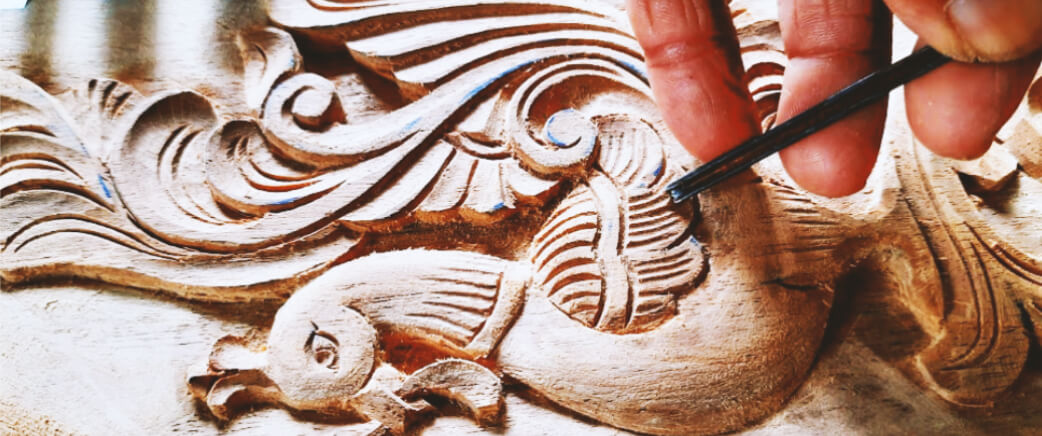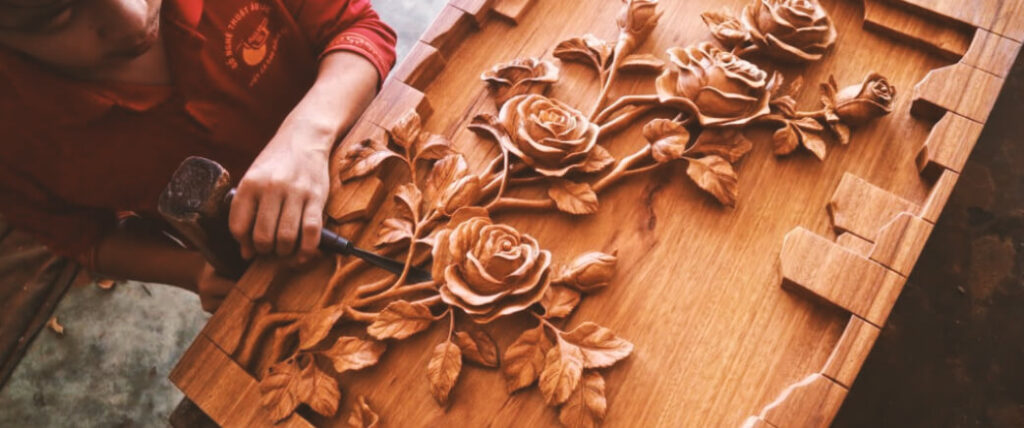
Wood Carving Process
The tools used, the types of wood utilized, and many other factors can be used to categorize different wood carving techniques. Most of these techniques require the use of a chisel or cutting tool. Techniques for cutting wood include the following:
- Whittling
- Chip carving
- Relief carving
Whittling: A Delicate Dance of Blades and Wood

At its core, whittling is a captivating act of carving where a practitioner employs a cutting tool, typically a small knife, to meticulously remove minuscule pieces of wood. The appeal of this technique lies not only in its simplicity but also in the freedom it offers to artisans, making it an ideal starting point for beginners and a therapeutic pursuit for seasoned craftsmen. The essence of whittling involves using the cutting tool to shape and mold the wooden canvas, unveiling new forms with each calculated stroke.
The dance begins with a choice of wood, and the whittler carefully selects a piece that aligns with the envisioned creation. Whether crafting intricate figurines or revealing mesmerizing patterns within the grain, the initial cuts mark the inception of a dialogue between the artist and the chosen material. The artisan’s fingers become attuned to the resistance and texture of the wood, guiding the trajectory of the blade in a symphony of controlled movements.
The process unfolds as a series of deliberate actions, each cut contributing to the gradual emergence of the envisioned design. The whittler, with a keen eye and steady hand, navigates the contours of the wood, allowing the knife to unveil the latent beauty within. It is a tactile journey, where the craftsman not only envisions the form but also feels its evolution beneath their fingertips.
Beyond the technical nuances, whittling is an art form that engages the senses. The gentle slicing of the knife through the wood, the fragrance of freshly carved timber, and the evolving shape under the whittler’s touch create a multisensory experience. This tactile engagement enhances the connection between the artist and the material, fostering a deep sense of immersion and intimacy with the creative process.
Whittling is a craft that demands patience and precision. Each cut carries significance, contributing to the overall composition. The choice of blades, the angle of the cut, and the understanding of the wood’s inherent characteristics become crucial elements in this delicate ballet of craftsmanship. The artisan must be attuned to the subtleties, navigating the challenges posed by different grains and textures.
As the final strokes complete the envisioned form, the whittler witnesses the transformation of a simple piece of wood into a unique work of art. The result is not merely a carved creation but a manifestation of the dialogue between the artisan’s intent and the inherent qualities of the material. Whittling, in its nuanced execution, is an art form that encapsulates the essence of craftsmanship, transforming a basic material into an expression of creativity and skill.

Chip Carving: Precision in Wood Sculpting

Craftsmen begin by skillfully wielding a sharp knife, carefully sculpting away wood chips to reveal delicate designs. Each cut is a deliberate act, contributing to the overall precision of the piece. Chip carving’s beauty lies not only in the final creation but also in the methodical nature of the journey.
Two primary patterns, geometric chip carving and free-form chip carving, serve as the foundational elements of this artistic technique. Geometric chip carving relies on angles and repeated motifs, creating patterns with mathematical elegance. In contrast, free-form chip carving allows for spontaneous expressions, encouraging artisans to unleash creativity and carve patterns that defy rigid structures.
The craftsman’s skill is evident in navigating the wood’s grain, ensuring that each cut enhances the intended pattern. Chip carving demands both technical prowess and artistic intuition, as the artisan transforms a static material into a dynamic and visually captivating creation. This technique, rooted in tradition, is a testament to the marriage of precision and creativity in the realm of wood carving.
Relief Carving:Crafting Dimension on a Wooden Canvas

This method transforms a seemingly two-dimensional surface into a captivating tableau of forms and textures. Figures come to life, delicately bridging the realms of imagination and reality. In the world of relief carving, the depth of expression is not only in the protrusion but also in the interplay of light and shadow that brings the carved motifs to vivid life.
Wood Selection
Chisels – “Ulli” in Local Vernacular
The artisan’s prowess is epitomized by a collection of chisels, locally known as “Ulli.” These finely crafted tools, each designed for a specific purpose, become extensions of the artisan’s hands. With deft strokes, they carve and shape the wood, translating visions into tangible forms.
Design Instruments – Scale and Pencil
Simple yet indispensable, the scale and pencil orchestrate the initial dance on the wood. With precise markings and intricate drawings, they lay the groundwork for the intricate patterns that will grace the surface. KG Cardboard joins the ensemble, providing a tangible platform for refining and envisioning designs.
Precision Tools – Carbon Sheets and L-shaped Ruler
Carbon sheets serve as guides, allowing artisans to transfer intricate designs seamlessly onto the wood. The L-shaped ruler, a beacon of accuracy, ensures edges are measured with meticulous care, contributing to the overall precision and balance of the carving.
Mechanical Marvel – Router Machine
In the contemporary woodcarver’s toolkit, the router machine takes center stage. This mechanical virtuoso, handled with expertise, meticulously scrapes away unwanted areas of the design. Its efficiency blends seamlessly with traditional craftsmanship, allowing for intricate detailing and a harmonious fusion of old and new.
As the creation takes form, the final touches come into play. Wax, carefully applied, not only polishes the item but adds a touch of regal elegance. Sandpaper, a modest yet essential companion, smoothens the surface, ensuring a tactile and visually appealing final product.
In the hands of these skilled artisans, these tools cease to be mere instruments; they become conduits for storytelling and artistic expression. The symphony of woodcarving unfolds as each tool, guided by a masterful hand, contributes to the creation of timeless wonders that resonate with the soul of the craftsman and the spirit of the wood itself.




